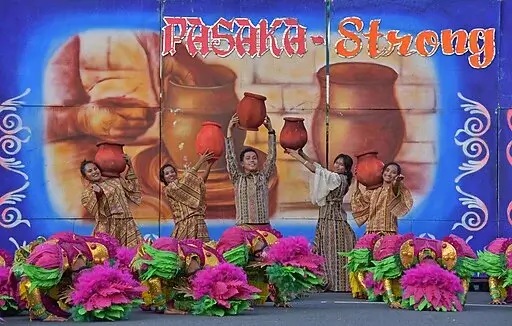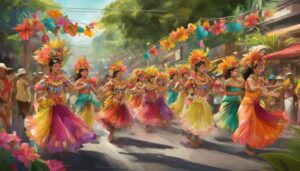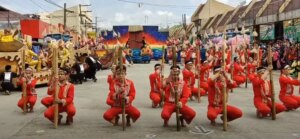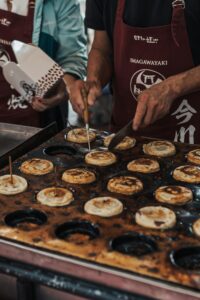
Pasaka Festival Philippines
Image credit: Wikimedia Commons
Like a vibrant tapestry woven with tradition and faith, the Pasaka Festival in Tanauan, Leyte, Philippines invites you into a rich cultural experience.
You’ll dive into a vivid spectacle of dance and music, celebrating the Assumption of the Virgin Mary. Each year, locals and tourists alike unleash their spirit of freedom as they partake in this grand religious procession.
You’ll witness the town’s devotion, expressed through elaborate dance rituals and thanksgiving traditions, reflecting the deeply ingrained Marian devotion in the local culture.
In this festival, you’re not just an observer, you’re part of an enduring story of faith, freedom, and gratitude.
So, come, and immerse yourself in the Pasaka Festival, a living testament to the Filipino spirit.
Key Takeaways
- Pasaka Festival celebrates the community’s faith and gratitude for bountiful harvests, showcasing their talent and culture.
- The festival involves vibrant dances, ornate costumes, lively music, and a grand religious procession that traces the footprints of ancestors.
- Tanauan Leyte Dance Rituals and Thanksgiving Traditions preserve the vibrant culture and rich history of Tanauan, fostering unity and cultural survival.
- The festival deeply integrates Marian devotion, highlighting the connection between faith and culture, and inspiring spiritual reflection and renewal.
Facts About Pasaka Festival Philippines
| Facts | Explanation |
|---|---|
| Festival Name | Pasaka Festival Philippines |
| Type of Festival | Cultural Festival |
| Festival Etymology | The word “Pasaka” is derived from the Cebuano term which means “to invite” or “to call upon.” |
| Brief History of the Festival | The Pasaka Festival is an annual celebration in the city of Tanauan, Leyte, Philippines. It was first organized in 2006 to promote the cultural heritage and traditions of the region. The festival aims to showcase the history, customs, and artistic talents of the local community. Throughout the years, the Pasaka Festival has grown into a major event that attracts both locals and tourists from different parts of the country. |
| Brief History of the City | Tanauan City is located in the province of Leyte in the Eastern Visayas region of the Philippines. It is known as the “City of Charm” and is rich in historical significance. Tanauan played a crucial role during World War II as it served as the headquarters of General Douglas MacArthur during the liberation of the Philippines. Today, Tanauan City is a thriving urban center with a mix of modern developments and preserved cultural landmarks. |
| Location of the City | Tanauan City is situated in the province of Leyte, which is located in the Eastern Visayas region of the Philippines. |
| How to Reach the City | The Pasaka Festival is an annual celebration in the city of Tanauan, Leyte, Philippines. It was first organized in 2006 to promote the cultural heritage and traditions of the region. The festival aims to showcase the history, customs, and artistic talents of the local community. Throughout the years, the Pasaka Festival has grown into a major event that attracts both locals and tourists from different parts of the country. |
| Nearby Cities/Towns and Their Distance | The main ethnic group in Tanauan City is the Waray-Waray people. They have their distinct language, culture, and traditions. The Waray-Waray are known for their resilience and strong sense of community. |
| Google Map Link | Google Map Link to Tanauan City |
| Ethnic Information | The main ethnic group in Tanauan City is the Waray-Waray people. They have their own distinct language, culture, and traditions. The Waray-Waray are known for their resilience and strong sense of community. |
| Festival Main Events and Activities | – Street Parade showcasing traditional dances, music, and costumes – Cultural Performances featuring local talents – Beauty Pageants highlighting local beauty and grace – Trade Fairs showcasing local products and crafts – Food Festivals offering traditional delicacies |
| Other Famous Tourist Attractions | – MacArthur Landing Memorial National Park – Sto. Niño Shrine and Heritage Museum – San Juanico Bridge (connecting Leyte and Samar) – Leyte Provincial Capitol – Palo Cathedral – Lake Bito – Beaches in Tolosa and Dulag |
| Famous Food Dishes | – Binagol (a traditional delicacy made from grated coconut and sweetened taro) – Moron (sticky rice roll with chocolate filling) – Suman (sticky rice snack wrapped in banana leaves) – Leyte’s Seafood Dishes (e.g., Kinilaw, Grilled Fish) |
| Landmarks in the City | – Tanauan City Hall – Saint Therese of Lisieux Parish Church – Leyte Normal University – Tanauan Municipal Plaza – Tanauan Park and Beach Resort – Balyuan Amphitheater |
| Related Festivals in the Region | – Pintados-Kasadyaan Festival in Tacloban City, Leyte – Sinulog Festival in Cebu City, Cebu – Sangyaw Festival in Tacloban City, Leyte – Karansa Festival in Danao City, Cebu – Kadayawan Festival in Davao City, Davao del Sur |
Understanding the Pasaka Festival
To truly appreciate the Pasaka Festival, you’ll need to delve into its rich history and understand its cultural significance.
This festival’s origins lie deep within the heart of Tanauan, Leyte in the Philippines. It’s a celebration of the community’s deep-rooted faith and gratitude for bountiful harvests.
The vibrant dances, ornate costumes, and lively music you’ll witness are a testament to the community involvement that keeps this tradition alive. Annually, townsfolk actively participate, taking pride in showcasing their talent and culture. It’s a liberating experience, a time where everyone’s free to express their joy, faith, and unity.
Understanding the Pasaka Festival isn’t just about observing the festivities, it’s about immersing yourself in a community that values freedom, faith, and unity.
Our Lady of Assumption Significance
Every part of the Pasaka Festival is steeped in meaning, and one key aspect you’ll encounter is the significance of Our Lady of Assumption. This revered figure represents Mary’s Dormition, her ‘falling asleep’ or death, and subsequent Assumption into Heaven.
At the festival, you’ll see Assumption iconography depicting this sacred event. These images serve a dual purpose: they educate about religious history and inspire reverence for Mary’s divine journey.
The Assumption’s significance transcends the religious sphere, symbolizing the freedom you desire. It’s a message of liberation, a testament to the belief that there’s a spiritual realm beyond earthly confines.
The Grand Religious Procession
As we journey further into the heart of the Pasaka Festival, let’s turn our attention to the Grand Religious Procession.
You’ll find the historical significance of this event fascinating, as it intertwines with the cultural fabric of Tanauan, Leyte.
We’ll also shine a spotlight on the various groups participating, each contributing to the vibrant tapestry that makes the procession a sight to behold.
Procession’s Historical Significance
You’re about to delve into the historical significance of the Grand Religious Procession, a critical element of the Pasaka Festival in Tanauan, Leyte, Philippines. This procession isn’t just a religious parade; it’s a living embodiment of the town’s history and culture.
- Procession Routes: These aren’t just paths; they’re historical tapestries, tracing the footprints of ancestors.
- Historical Artifacts: Carried during the procession, these relics connect the past, present, and future.
- Cultural Significance: The procession’s rituals and practices are an affirmation of cultural identity.
- Spiritual Freedom: It’s a celebration of religious liberty, embracing diversity and unity.
The procession is a journey through time, a testament to the enduring spirit of the town’s people. Through this, you’ll understand the freedom that lies in their rich history.
Participating Groups Overview
Often, you’ll find a diverse range of groups participating in the Grand Religious Procession, each contributing its unique flair and fervor to the event.
They come decked out in vibrant Festival Attires, complete with props and paraphernalia, creating a riot of colors. Not to mention, the Food Delicacies that are a huge part of the celebration, each group proudly presenting their special treats.
Here’s a brief overview of the participating groups and what they bring to the table:
| Group | Contribution |
|---|---|
| The Youth | Energetic dances, youthful enthusiasm |
| Local Artisans | Intricate Festival Attires, handcrafted items |
| Food Vendors | Array of Food Delicacies, local flavors |
You see, everyone’s participation adds a unique charm, making the procession a grand spectacle worth experiencing.
Location Of Tanauan, Leyte, Philippines
How To Reach Tanauan, Leyte, Philippines
To reach Tanauan, Leyte, Philippines, you can follow these general directions:
- By Air:
- Book a flight to Daniel Z. Romualdez Airport (also known as Tacloban Airport), which is the nearest airport to Tanauan, Leyte.
- From Tacloban Airport, you can hire a taxi or take a van or bus to Tanauan. The journey takes approximately 1-2 hours, depending on traffic conditions.
- By Sea:
- If you prefer to travel by sea, you can take a ferry or a boat to Tacloban City.
- From Tacloban City, you can hire a taxi or take a van or bus to Tanauan. The travel time is around 1-2 hours.
It’s always a good idea to check the latest transportation options and schedules before your trip.
Tanauan Leyte Dance Rituals
As we move forward in our exploration of the Pasaka Festival in Tanauan, Leyte, let’s turn our attention to the dance rituals, a vibrant expression of faith and culture.
You’ll find the significance of traditional dances deeply rooted in the heart of this celebration.
From the intricate steps to the rhythmic patterns, each detail holds a rich historical and spiritual meaning.
Traditional Dance Significance
In the Pasaka Festival, the traditional dances you’ll encounter mirror the vibrant culture and rich history of Tanauan, Leyte. These performances, with their colorful dance costumes and energetic movements, aren’t just for show. They play a crucial role in cultural preservation, serving as a living testament to the town’s heritage.
The significance of these dances can be broken down into four main points:
- They tell a story: Each dance narrates a piece of Tanauan’s history, allowing you to better understand their past.
- They represent identity: The dances reflect the unique cultural identity of Tanauan.
- They promote unity: The collective performances foster a sense of community and camaraderie.
- They ensure cultural survival: By keeping these traditions alive, the people of Tanauan ensure their culture’s longevity.
Ritual Dance Steps
One of the highlights of the Pasaka Festival is the traditional ritual dance, which is performed with utmost grace and precision. The ritual dance steps in the Pasaka Festival hold great significance and are deeply rooted in the local traditions and beliefs.
The dance begins with a ceremonial procession, where the performers wear colorful traditional costumes that represent various elements of nature and mythical creatures. The dancers move gracefully in sync with the rhythmic beats of traditional music, creating a mesmerizing spectacle for the spectators.
The first set of ritual dance steps often involves slow and deliberate movements, symbolizing the connection between humankind and nature. The dancers imitate the movements of animals, such as birds, snakes, or deer, to depict their harmonious coexistence with the natural world. These steps are performed with precision and grace, embodying the spirit of reverence for nature.
As the dance progresses, the tempo gradually increases, and the dancers transition into more energetic and dynamic movements. They execute intricate footwork, leaps, and spins, showcasing their agility and skill. The performers often use props like fans, scarves, or ribbons to enhance the visual appeal of the dance.
Throughout the performance, the dancers maintain a strong sense of unity and synchronization. Their movements are perfectly coordinated, reflecting the collective spirit and harmony of the community. The dancers also engage in intricate formations, creating captivating patterns that add to the overall beauty of the dance.
The ritual dance steps in the Pasaka Festival are not only a form of artistic expression but also serve as a medium to convey cultural values and beliefs. They reflect the deep-rooted connection between the people and their ancestral traditions. Through these dance steps, the performers pay homage to their ancestors and express gratitude for the bounties of nature.
The Pasaka Festival ritual dance steps are a testament to the rich cultural heritage of Tanauan, Leyte in the Philippines. They showcase the community’s reverence for nature, their unity as a group, and their commitment to preserving their traditions. This dance form serves as a captivating spectacle for both locals and visitors alike, leaving a lasting impression of the vibrant culture of the region.
Thanksgiving Traditions in Tanauan

During the Pasaka Festival, you’ll notice that Thanksgiving traditions in Tanauan aren’t just an afterthought, but a pivotal part of their cultural identity. Tanauan culinary traditions come alive as the community gathers to feast on local delicacies. Here’s what you can expect:
- Locals prepare ‘Lechon’, a whole roasted pig, symbolizing abundance and unity.
- Community bonding activities include sharing meals, exchanging stories, and playing traditional games.
- Thanksgiving in Tanauan is also marked by ‘Bayanihan’, a unique Filipino practice of communal unity and cooperation.
- This tradition culminates with a communal prayer, thanking God for their blessings.
These Thanksgiving traditions, embedded in the Pasaka Festival, represent not just a time of gratitude, but also a celebration of unity, freedom, and cultural identity.
Marian Devotion and Local Culture
You’ll find that the Marian devotion deeply influences the local culture at the Pasaka Festival. The community’s faithfulness is reflected in the event’s Marian iconography, linking worship and local tradition. The festival is a testament to the people’s free expression of faith and cultural heritage.
| Marian Iconography | Community Faithfulness |
|---|---|
| Depicted in festival arts and crafts | Visible in collective participation |
| Integrated in folk dances and songs | Evident in the preservation of traditions |
| Emphasized in religious processions | Demonstrated in communal prayer sessions |
You’re not just witnessing a festival, you’re stepping into a living testament of a culture’s enduring faith and freedom.
The Pasaka Festival isn’t merely a spectacle; it’s a vibrant reflection of Leyte’s historical and spiritual legacy. This fusion of Marian devotion and local culture creates an experience that is both enlightening and enriching.
Famous Festival Dishes of Pasaka Festival Leyte
| Food | Description |
|---|---|
| Pinangat | A popular dish made with taro leaves, coconut milk, and various seafood such as shrimp, fish, or crab. The ingredients are wrapped in taro leaves and cooked until tender. Pinangat has a rich and creamy flavor with a hint of spiciness. |
| Biko | A traditional Filipino rice cake made from glutinous rice, coconut milk, and brown sugar. It is usually topped with latik, a caramelized coconut milk sauce. Biko is sticky and sweet, with a slightly chewy texture. It is often served during special occasions like Pasaka Festival. |
| Lechon | A roasted whole pig that is commonly served during festive occasions in the Philippines. The pig is marinated in a mixture of herbs and spices, then slowly roasted over an open fire until the skin becomes crispy and the meat tender and flavorful. Lechon is often the centerpiece of Pasaka Festival feasts. |
| Kakanin | A variety of traditional Filipino rice cakes made from glutinous rice. Some popular Kakanin dishes include puto (steamed rice cake), Bibingka (rice cake baked in banana leaves), and Suman (sticky rice rolls). Kakanin is often enjoyed as a snack or dessert during the Pasaka Festival. |
| Pancit Malabon | A type of Filipino noodle dish that originated in Malabon City. It is made with thick rice noodles, and various seafood such as shrimp, squid, and smoked fish, and topped with a rich sauce made from shrimp broth and annatto seeds. Pancit Malabon is a flavorful and filling dish commonly served during the Pasaka Festival. |
| Halo-Halo | A popular Filipino dessert that consists of crushed ice topped with various ingredients such as sweetened fruits, jellies, beans, leche flan (caramel custard), and ube (purple yam) ice cream. It is a refreshing and colorful treat enjoyed during the Pasaka Festival to beat the heat. |
Please note that this table provides a brief description of some famous foods commonly associated with the Pasaka Festival in the Philippines. The actual food offerings may vary depending on the specific region or community celebrating the festival.
Summary of Sinukwan Pasaka Festival Philippines
| Information | Source |
|---|---|
| Name of the Festival | Pasaka Festival |
| Location | Tanauan, Leyte |
| Frequency | Annual (typically held from August 14-16) |
| Meaning of “Pasaka” | Invitation to progress, health, and luck |
| Main Attraction | Town Fiesta |
| Language Origin | Waray-waray (local language) |
| Cultural Elements | Indigenous dance-dramas, colorful parade |
| Significance | Celebration of unity, faith, and abundance |
| Historical Roots | Deeply rooted in Tanauan’s rich history |
| Related Search Queries | Pasaka festival in Tanauan Leyte history, Pasaka festival in Tanauan Leyte essay, Pasaka festival in Tanauan Leyte description, Importance of Pasaka festival in Tanauan Leyte, Pasaka festival of Pantukan |
Conclusion
The Pasaka Festival in Tanauan, Leyte, Philippines is a vibrant celebration deeply rooted in tradition and faith. From the grand religious procession to the intricate dance rituals and thanksgiving traditions, this festival is a living testament to the community’s unity, faith, and cultural identity.
The festival showcases the rich history and artistic talents of the local community, inviting both locals and tourists to immerse themselves in a celebration of life, culture, and tradition.
With its colorful parade, indigenous dance dramas, and traditional Filipino dishes, the Pasaka Festival is a unique experience that captures the heart and spirit of Tanauan, Leyte.
Frequently Asked Questions
What Is the Best Time to Visit Tanauan, Leyte for the Pasaka Festival?
You’d want to visit Tanauan, Leyte in August. That’s when they celebrate the Pasaka Festival. You’ll be immersed in its rich history and cultural significance, truly a unique experience you wouldn’t want to miss.
Are There Any Local Dishes or Foods Traditionally Associated With the Pasaka Festival?
Yes, there are! You’ll find traditional Filipino dishes like Lechon and Pancit linked to the Pasaka Festival’s cultural impact. The festival’s origins are rooted in celebrating local culture, including their delicious cuisine.
How Do Locals Prepare for the Pasaka Festival?
You’d start preparations by securing festival financing, ensuring everything’s environmentally friendly. Locals may form committees, plan events, design costumes, and practice performances. It’s an exciting, vibrant lead-up that brings the community together.
Are Tourists Allowed to Participate in the Dance Rituals or Other Festival Activities?
You’re allowed to join in the festivities. However, keep in mind the importance of tourist etiquette and cultural sensitivity. You’re free to participate, but remember to respect local customs and traditions.
Is There Any Specific Attire or Dress Code to Follow During the Pasaka Festival?
Sure, there’s no specific dress code, but it’s best to respect the cultural significance. Traditional Filipino attire aligns with the festival’s origins and will make you feel more part of the celebration.
Conclusion
In the heart of Tanauan, Leyte, the Pasaka Festival emerges as an annual celebration that transcends time. Rooted in tradition and adorned with vibrant colors, this cultural extravaganza, held from August 14 to 16, has become the town’s pride and the country’s best.
From dance dramas capturing hearts on Facebook to clinching victory in the Pintados-Kasadyaan Festival, the Pasaka Festival stands as a symbol of resilience and cultural richness. More than a spectacle, it’s a testament to Tanauan’s unity, faith, and abundance.
As we conclude our journey through Pasaka Festival’s online footprint, we’ve glimpsed a captivating celebration deeply embedded in Tanauan’s history. It’s not just an event; it’s a vibrant expression of gratitude, showcasing the town’s unwavering commitment to preserving its cultural identity.
In essence, the Pasaka Festival isn’t merely witnessed; it’s experienced, echoing the spirit of Tanauan, Leyte, and inviting all to partake in a celebration of life, culture, and tradition.







